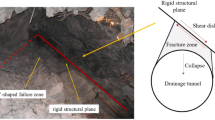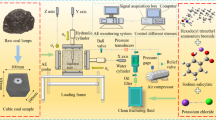Abstract
Pore fluid significantly affects the mechanical property of rocks. To understand the effect of heterogeneous distribution of pore water with high pressure, two partly saturated specimens of lower Shaximiao sandstone, which is a typical reservoir rock in Sichuan Basin, China, were performed under triaxial compression. The distribution of pore water was first derived from the ultrasonic mapping due to the obvious sensitivity of P-wave velocity to water infiltration. Owing to the direct measurements of multichannel P-wave velocity and injected fluid volume, the specimens along the axial direction could be divided into three sections: saturated (Sw ~ 100%), partially saturated (Sw < 100%), and dry regions (Sw ~ 0%), enabling us to investigate the fracturing behaviors around dry/wet boundary and examine the possibility of developing an interactive wet/dry mixed fracturing technology. The microcrack activity and fracturing process was captured by acoustic emission monitoring, and finally verified by X-ray computed tomography images after the experiments. Our results indicate that flooding region with higher pore pressure benefits earlier fracturing. Fracture initiated in the saturated region and migrated toward to the partially saturated and dry regions. As a result, heterogeneous distribution of pore water and pore pressure benefits the formation of complex microcrack network around the wet/dry boundary (partially saturated region) and induced seismicity with higher b-value. Thus, it seems to be promising to develop an interactive wet/dry mixed fracturing technology, which facilitates the formation of complex fracture networks and reduces the risk of induced earthquakes. These results may provide interesting references for applications related to hydraulic fracturing of tight sandstone.
Highlights
-
Partly saturated tight sandstone was compressed to failure under triaxial compression.
-
Fracture initiated in the saturated region and migrated toward to the partially saturated and dry regions.
-
Heterogeneous distribution of pore water with high pressure benefits the formation of complex microcrack network.
-
An interactive wet/dry mixed fracturing technology may be effective for tight formation.












Similar content being viewed by others
Availability of Data and Materials
The data that support the findings of this study are available from the corresponding author.
References
Baud P, Zhu W, Wong T-F (2000) Failure mode and weakening effect of water on sandstone. J Geophys Res Solid Earth 105:16371–16390. https://doi.org/10.1029/2000jb900087
Bin W, XiangZhong C, Juan C, Jun Y, KaiJun T (2020) Elastic characteristics and petrophysical modeling of the Jurassic tight sandstone in Sichuan Basin. Chin J Geophys Chin Edn 63:4528–4539. https://doi.org/10.6038/cjg2020O0346
Dautriat J, Sarout J, David C, Bertauld D, Macault R (2016) Remote monitoring of the mechanical instability induced by fluid substitution and water weakening in the laboratory. Phys Earth Planet Inter 261:69–87. https://doi.org/10.1016/j.pepi.2016.06.011
David C, Dautriat J, Sarout J, Delle P, Menéndez BC, Macault R, Bertauld D (2015) Mechanical instability induced by water weakening in laboratory fluid injection tests. J Geophys Res Solid Earth 120:4171–4188. https://doi.org/10.1002/2015jb011894
De Bresser JHP, Urai JL, Olgaard DL (2005) Effect of water on the strength and microstructure of Carrara marble axially compressed at high temperature. J Struct Geol 27:265–281. https://doi.org/10.1016/j.jsg.2004.10.002
Duda M, Renner J (2012) The weakening effect of water on the brittle failure strength of sandstone. Geophys J Int 192:1091–1108. https://doi.org/10.1093/gji/ggs090
Erguler ZA, Ulusay R (2009) Water-induced variations in mechanical properties of clay-bearing rocks. Int J Rock Mech Min Sci 46:355–370. https://doi.org/10.1016/j.ijrmms.2008.07.002
Gerald JDF, Boland JN, McLaren AC, Ord A, Hobbs BE (1991) Microstructures in water-weakened single crystals of quartz. J Geophys Res Solid Earth 96:2139. https://doi.org/10.1029/90jb02190
Hadizadeh J, Law RD (1991) Water-weakening of sandstone and quartzite deformed at various stress and strain rates. Int J Rock Mech Min Sci Geomech Abstr 28:431–439. https://doi.org/10.1016/0148-9062(91)90081-V
Hawkins AB, McConnell BJ (1992) Sensitivity of sandstone strength and deformability to changes in moisture content. Q J Eng Geol Hydrogeol 25:115–130. https://doi.org/10.1144/GSL.QJEG.1992.025.02.05
He M, Li Q, Li X (2020) Injection-induced seismic risk management using machine learning methodology—a perspective study. Front Earth Sci 8:227. https://doi.org/10.3389/feart.2020.00227
Heggheim T, Madland MV, Risnes R, Austad T (2005) A chemical induced enhanced weakening of chalk by seawater. J Pet Sci Eng 46:171–184. https://doi.org/10.1016/j.petrol.2004.12.001
Lei X (2019) Evolution of b-value and fractal dimension of acoustic emission events during shear rupture of an immature fault in granite. Appl Sci 9:2498. https://doi.org/10.3390/app9122498
Lei X, Kusunose K, Rao MVMS, Nishizawa O, Satoh T (2000) Quasi-static fault growth and cracking in homogeneous brittle rock under triaxial compression using acoustic emission monitoring. J Geophys Res Solid Earth 105:6127. https://doi.org/10.1029/1999jb900385
Lei X, Tamagawa T, Tezuka K, Takahashi M (2011) Role of drainage conditions in deformation and fracture of porous rocks under triaxial compression in the laboratory. Geophys Res Lett 38(24):L24310. https://doi.org/10.1029/2011gl049888
Lei X, Su J, Wang Z (2020) Growing seismicity in the Sichuan Basin and its association with industrial activities. Sci China Earth Sci 63:1633–1660. https://doi.org/10.1007/s11430-020-9646-x
Li X, Lei X, Li Q (2016) Injection-induced fracturing process in a tight sandstone under different saturation conditions. Environ Earth Sci 75:1466. https://doi.org/10.1007/s12665-016-6265-2
Li S, Zhang S, Ma X, Zou Y, Li N, Chen M, Cao T, Bo Z (2019) Hydraulic fractures induced by water-/carbon dioxide-based fluids in tight sandstones. Rock Mech Rock Eng 52:3323–3340. https://doi.org/10.1007/s00603-019-01777-w
Li X, Lei X, Li Q (2021a) Fault nucleation of tight sandstone by investigation of mechanical, acoustic, and hydraulic responses. Eng Geol 292:106254. https://doi.org/10.1007/s12665-016-6265-2
Li X, Lei X, Li Q, Chen D (2021b) Influence of bedding structure on stress-induced elastic wave anisotropy in tight sandstones. J Rock Mech Geotech Eng 13:98–113. https://doi.org/10.1016/j.jrmge.2020.06.003
Liteanu E, Spiers CJ, de Bresser JHP (2013) The influence of water and supercritical CO2 on the failure behavior of chalk. Tectonophysics 599:157–169. https://doi.org/10.1016/j.tecto.2013.04.013
Makhnenko RY, Labuz JF (2015) Dilatant hardening of fluid-saturated sandstone. J Geophys Res Solid Earth 120:909–922. https://doi.org/10.1002/2014jb011287
Middleton RS, Carey JW, Currier RP, Hyman JD, Kang Q, Karra S, Jiménez-Martínez J, Porter ML, Viswanathan HS (2015) Shale gas and non-aqueous fracturing fluids: opportunities and challenges for supercritical CO2. Appl Energy 147:500–509. https://doi.org/10.1016/j.apenergy.2015.03.023
Nicolas A, Blöcher G, Kluge C, Li Z, Hofmann H, Pei L, Milsch H, Fortin J, Guéguen Y (2020) Pore pressure pulse migration in microcracked andesite recorded with fibre optic sensors. Geomech Energy Environ 24:100183. https://doi.org/10.1016/j.gete.2020.100183
Risnes R, Madland MV, Hole M, Kwabiah NK (2005) Water weakening of chalk—Mechanical effects of water–glycol mixtures. J Petrol Sci Eng 48:21–36. https://doi.org/10.1016/j.petrol.2005.04.004
Stanchits S, Mayr S, Shapiro S, Dresen G (2011) Fracturing of porous rock induced by fluid injection. Tectonophysics 503:129–145. https://doi.org/10.1016/j.tecto.2010.09.022
Urai JL, Spiers CJ, Zwart HJ, Lister GS (1986) Weakening of rock salt by water during long-term creep. Nature 324:554–557. https://doi.org/10.1038/324554a0
Vásárhelyi B, Ván P (2006) Influence of water content on the strength of rock. Eng Geol 84:70–74. https://doi.org/10.1016/j.enggeo.2005.11.011
Wang L, Kwiatek G, Rybacki E, Bonnelye A, Bohnhoff M, Dresen G (2020) Laboratory study on fluid-induced fault slip behavior: the role of fluid pressurization rate. Geophys Res Lett 47(6):e2019gl086627. https://doi.org/10.1029/2019gl086627
Wasantha PLP, Ranjith PG (2014) Water-weakening behavior of Hawkesbury sandstone in brittle regime. Eng Geol 178:91–101. https://doi.org/10.1016/j.enggeo.2014.05.015
Wild KM, Amann F, Martin CD, Wassermann J, David C, Barla M (2015) Dilatancy of clay shales and its impact on pore pressure evolution and effective stress for different triaxial stress paths. In: The 49th U.S. Rock Mechanics/Geomechanics Symposium, San Francisco, California
Zhuang L, Jung SG, Diaz M, Kim KY, Hofmann H, Min K-B, Zang A, Stephansson O, Zimmermann G, Yoon J-S (2020) Laboratory true triaxial hydraulic fracturing of granite under six fluid injection schemes and grain-scale fracture observations. Rock Mech Rock Eng 53:4329–4344. https://doi.org/10.1007/s00603-020-02170-8
Zimmermann G, Zang A, Stephansson O, Klee G, Semiková H (2018) Permeability enhancement and fracture development of hydraulic in situ experiments in the Äspö Hard Rock Laboratory, Sweden. Rock Mech Rock Eng 52:495–515. https://doi.org/10.1007/s00603-018-1499-9
Acknowledgements
This work was partially supported by the National Natural Science Foundation of China (Grant No. 41902297), the Knowledge Innovation Program of Wuhan - Basic Research (Grant No. 2022010801010159), and the Major Project of Inner Mongolia Science and Technology (Grant No. 2021ZD0034).
Author information
Authors and Affiliations
Corresponding author
Ethics declarations
Conflict of Interest
The authors wish to confirm that there are no known conflicts of interest associated with this publication and there has been no significant financial support for this work that could have influenced its outcome.
Additional information
Publisher's Note
Springer Nature remains neutral with regard to jurisdictional claims in published maps and institutional affiliations.
Rights and permissions
Springer Nature or its licensor (e.g. a society or other partner) holds exclusive rights to this article under a publishing agreement with the author(s) or other rightsholder(s); author self-archiving of the accepted manuscript version of this article is solely governed by the terms of such publishing agreement and applicable law.
About this article
Cite this article
Li, X., Lei, X., Shen, H. et al. Fracturing Around Dry/Wet Boundary in Tight Sandstones Monitored by Micro-seismicity in Laboratory. Rock Mech Rock Eng 56, 3693–3708 (2023). https://doi.org/10.1007/s00603-023-03241-2
Received:
Accepted:
Published:
Issue Date:
DOI: https://doi.org/10.1007/s00603-023-03241-2




